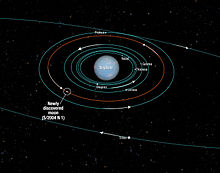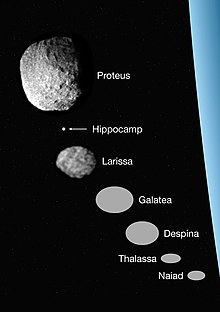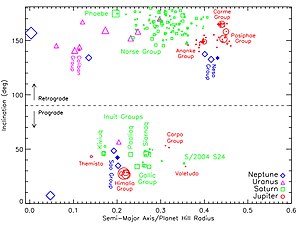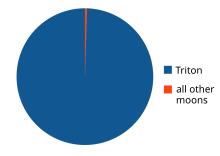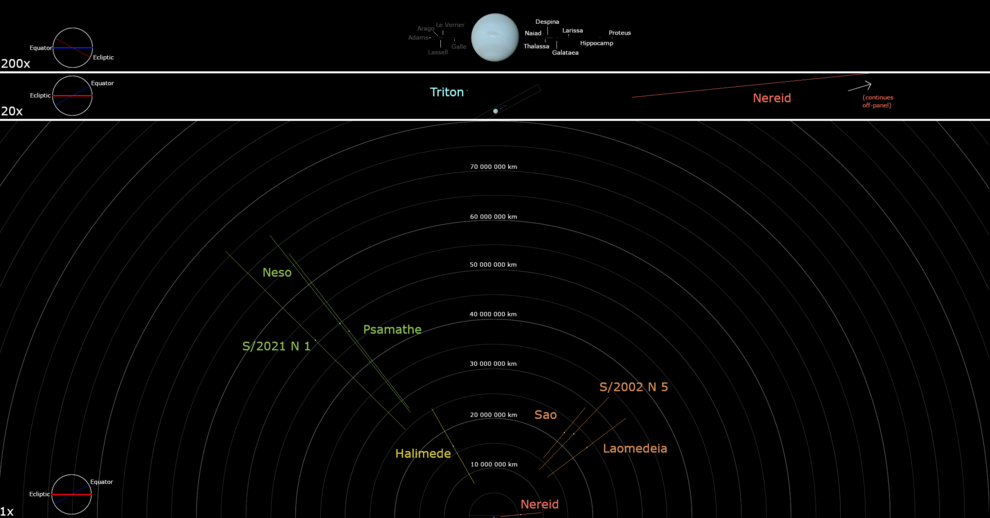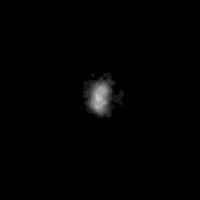
Nereid, or Neptune II, is the third-largest moon of Neptune. It has the most eccentric orbit of all known moons in the Solar System. It was the second moon of Neptune to be discovered, by Gerard Kuiper in 1949.

Triton is the largest natural satellite of the planet Neptune. It is the only moon of Neptune massive enough to be rounded under its own gravity and hosts a thin but well-structured atmosphere. Triton orbits Neptune in a retrograde orbit—an orbit in the direction opposite to its planet's rotation—the only large moon in the Solar System to do so. Triton is thought to have once been a dwarf planet, captured from the Kuiper belt into Neptune orbit.

A natural satellite is, in the most common usage, an astronomical body that orbits a planet, dwarf planet, or small Solar System body. Natural satellites are colloquially referred to as moons, a derivation from the Moon of Earth.

Proteus, also known as Neptune VIII, is the second-largest Neptunian moon, and Neptune's largest inner satellite. Discovered by Voyager 2 in 1989, it is named after Proteus, the shape-changing sea god of Greek mythology. Proteus orbits Neptune in a nearly equatorial orbit at a distance of about 4.75 times the radius of Neptune's equator.

Larissa, also known as Neptune VII, is the fifth-closest inner satellite of Neptune. It is named after Larissa, a lover of Poseidon.
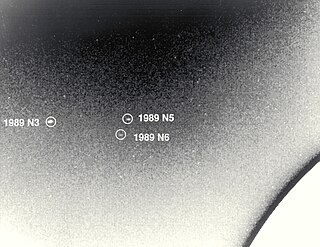
Thalassa, also known as Neptune IV, is the second-innermost satellite of Neptune. Thalassa was named after sea goddess Thalassa, a daughter of Aether and Hemera from Greek mythology. "Thalassa" is also the Greek word for "sea".
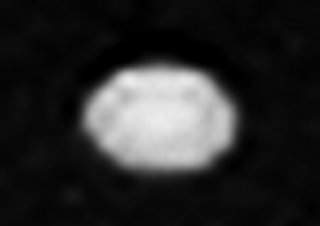
Despina, also known as Neptune V, is the third-closest inner moon of Neptune. It is named after Greek mythological character Despoina, a nymph who was a daughter of Poseidon and Demeter.
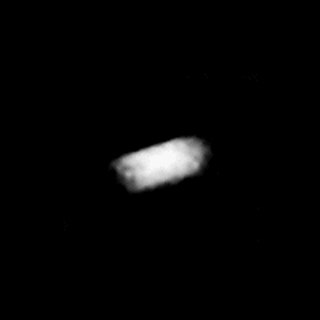
Galatea, also known as Neptune VI, is the fourth-closest inner moon of Neptune. It is named after Galatea, one of the fifty Nereids of Greek legend, with whom Cyclops Polyphemus was vainly in love.

Halimede, or Neptune IX, is a retrograde irregular satellite of Neptune. It was discovered by Matthew J. Holman, John J. Kavelaars, Tommy Grav, Wesley C. Fraser and Dan Milisavljevic on August 14, 2002.

Neso, also known as Neptune XIII, is the second-outermost known natural satellite of Neptune, after S/2021 N 1. It is a retrograde irregular moon discovered by Matthew J. Holman, Brett J. Gladman, et al. on 14 August 2002, though it went unnoticed until 2003. Neso is the second-most distant moon of Neptune, with an average orbital distance of over 49 million km. At its farthest point of its orbit, the satellite is more than 72 million km from Neptune. This distance exceeds Mercury's aphelion, which is approximately 70 million km from the Sun.

Psamathe, also known as Neptune X, is a retrograde irregular satellite of Neptune. It is named after Psamathe, one of the Nereids. Psamathe was discovered by Scott S. Sheppard and David C. Jewitt in 2003 using the 8.2 meter Subaru telescope. Before it was officially named on February 3, 2007, it was known by the provisional designation S/2003 N 1.

Uranus, the seventh planet of the Solar System, has 28 confirmed moons. Most of them are named after characters that appear in, or are mentioned in, the works of William Shakespeare and Alexander Pope. Uranus's moons are divided into three groups: thirteen inner moons, five major moons, and ten irregular moons. The inner and major moons all have prograde orbits and are cumulatively classified as regular moons. In contrast, the orbits of the irregular moons are distant, highly inclined, and mostly retrograde.

The rings of Neptune consist primarily of five principal rings. They were first discovered by simultaneous observations of a stellar occultation on 22 July 1984 by André Brahic's and William B. Hubbard's teams at La Silla Observatory (ESO) and at Cerro Tololo Interamerican Observatory in Chile. They were eventually imaged in 1989 by the Voyager 2 spacecraft. At their densest, they are comparable to the less dense portions of Saturn's main rings such as the C ring and the Cassini Division, but much of Neptune's ring system is quite faint and dusty, in some aspects more closely resembling the rings of Jupiter. Neptune's rings are named after astronomers who contributed important work on the planet: Galle, Le Verrier, Lassell, Arago, and Adams. Neptune also has a faint unnamed ring coincident with the orbit of the moon Galatea. Three other moons orbit between the rings: Naiad, Thalassa and Despina.
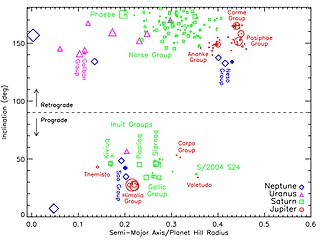
In astronomy, an irregular moon, irregular satellite, or irregular natural satellite is a natural satellite following a distant, inclined, and often highly elliptical and retrograde orbit. They have been captured by their parent planet, unlike regular satellites, which formed in orbit around them. Irregular moons have a stable orbit, unlike temporary satellites which often have similarly irregular orbits but will eventually depart. The term does not refer to shape; Triton, for example, is a round moon but is considered irregular due to its orbit and origins.
In astronomy, an inner moon or inner natural satellite is a natural satellite following a prograde, low-inclination orbit inwards of the large satellites of the parent planet. They are generally thought to have been formed in situ at the same time as the coalescence of the original planet. Neptune's moons are an exception, as they are likely reaggregates of the pieces of the original bodies, which were disrupted after the capture of the large moon Triton. Inner satellites are distinguished from other regular satellites by their proximity to the parent planet, their short orbital periods, their low mass, small size, and irregular shapes.
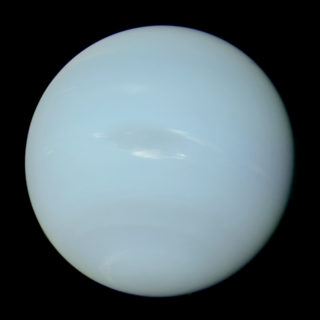
Neptune has been directly explored by one space probe, Voyager 2, in 1989. As of 2024, there are no confirmed future missions to visit the Neptunian system, although a tentative Chinese mission has been planned for launch in 2024. NASA, ESA, and independent academic groups have proposed future scientific missions to visit Neptune. Some mission plans are still active, while others have been abandoned or put on hold.

Retrograde motion in astronomy is, in general, orbital or rotational motion of an object in the direction opposite the rotation of its primary, that is, the central object. It may also describe other motions such as precession or nutation of an object's rotational axis. Prograde or direct motion is more normal motion in the same direction as the primary rotates. However, "retrograde" and "prograde" can also refer to an object other than the primary if so described. The direction of rotation is determined by an inertial frame of reference, such as distant fixed stars.

Hippocamp, also designated Neptune XIV, is a small moon of Neptune discovered on 1 July 2013. It was found by astronomer Mark Showalter by analyzing archived Neptune photographs the Hubble Space Telescope captured between 2004 and 2009. The moon is so dim that it was not observed when the Voyager 2 space probe flew by Neptune and its moons in 1989. It is about 35 km (20 mi) in diameter, and orbits Neptune in about 23 hours, just under one Earth day. Due to its unusually close distance to Neptune's largest inner moon Proteus, it has been hypothesized that Hippocamp may have accreted from material ejected by an impact on Proteus several billion years ago. The moon was formerly known by its provisional designation S/2004 N 1 until February 2019, when it was formally named Hippocamp, after the mythological sea-horse symbolizing Poseidon in Greek mythology.
The following outline is provided as an overview of and topical guide to Neptune:

S/2002 N 5 is a prograde irregular satellite of Neptune. It was discovered on 14 August 2002 by Matthew Holman, John J. Kavelaars, Tommy Grav, and Wesley Fraser using the 4.0-meter Víctor M. Blanco Telescope at Cerro Tololo Observatory, Chile, but it became lost and was not observed again until Scott S. Sheppard rediscovered it on 3 September 2021. The discovery of S/2002 N 5 was announced on 23 February 2024, after observations were collected over a long enough time to confirm the satellite's orbit. S/2002 N 5 orbits Neptune at an average distance of over 23 million km (14 million mi) and takes almost 9 Earth years to complete its orbit.

